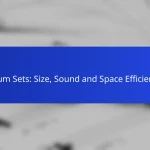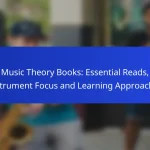Exploring music theory through books can significantly enhance your understanding and appreciation of music, whether you’re a beginner or an advanced musician. Essential reads provide clear explanations and practical exercises, catering to various skill levels and specific instruments. By focusing on unique aspects of each instrument, these books help learners master techniques, scales, and harmonies relevant to their musical journey.
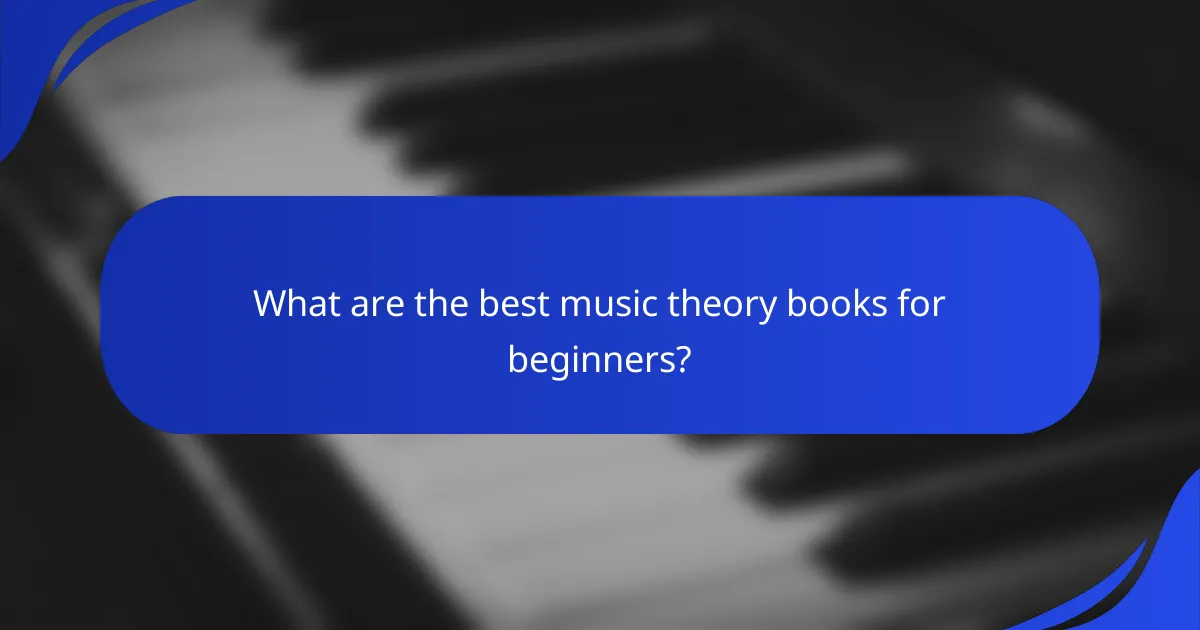
What are the best music theory books for beginners?
The best music theory books for beginners provide clear explanations of fundamental concepts and practical applications. They often include exercises and examples that help new learners grasp essential skills and knowledge in music theory.
“Tonal Harmony” by Stefan Kostka
“Tonal Harmony” is a widely used textbook that covers the principles of tonal music in a structured manner. It emphasizes harmony, voice leading, and the analysis of musical forms, making it suitable for both beginners and intermediate students.
This book includes numerous exercises and examples from classical repertoire, allowing readers to apply theoretical concepts to real music. Its clear layout and progressive approach help learners build a solid foundation in music theory.
“The Complete Musician” by Steven G. Laitz
“The Complete Musician” offers a comprehensive approach to music theory, integrating ear training, sight singing, and keyboard skills. This multi-faceted method ensures that beginners develop a well-rounded understanding of music.
The book features engaging exercises and a variety of musical styles, which can enhance the learning experience. Its focus on practical application helps students connect theory with performance, making it an excellent choice for aspiring musicians.
“How to Read Music” by A. J. McCaffrey
“How to Read Music” is an accessible guide designed for absolute beginners. It breaks down the basics of reading musical notation, including staff, notes, rhythms, and key signatures, in a straightforward manner.
This book is particularly useful for those who want to quickly grasp the essentials of music reading without overwhelming detail. Its clear explanations and practical exercises make it a valuable resource for anyone starting their musical journey.
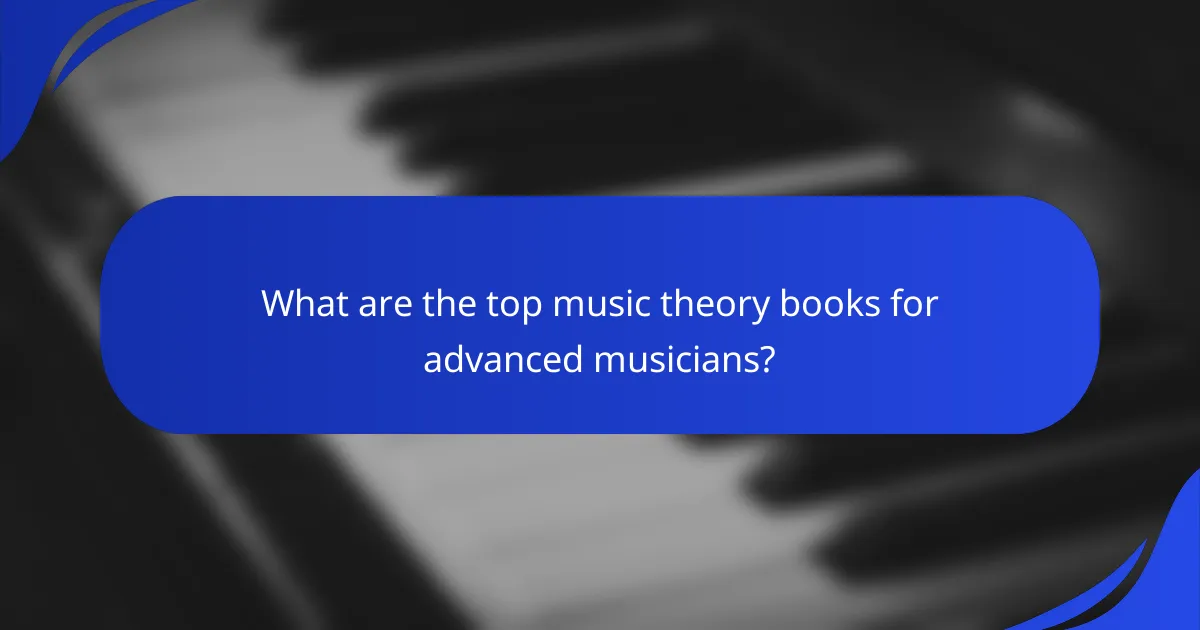
What are the top music theory books for advanced musicians?
Advanced musicians seeking to deepen their understanding of music theory should consider books that challenge their existing knowledge and expand their skills. Essential reads often cover complex concepts, offer practical applications, and cater to specific genres or instruments.
“The Jazz Theory Book” by Mark Levine
Mark Levine’s “The Jazz Theory Book” is a comprehensive resource for musicians interested in jazz. It covers fundamental concepts such as scales, chords, and improvisation techniques, making it suitable for both beginners and advanced players. The book includes practical exercises and examples that help musicians apply theory to real-world jazz contexts.
Key features include clear explanations of complex topics and a focus on the unique aspects of jazz harmony. Musicians can benefit from the numerous musical examples that illustrate the application of theory in improvisation and composition.
“Counterpoint” by Kent Kennan
Kent Kennan’s “Counterpoint” is a seminal text that delves into the art of counterpoint, a crucial aspect of Western music theory. This book explores the techniques of writing and analyzing counterpoint, emphasizing the importance of melodic independence and harmonic coherence. It is particularly valuable for composers and those studying classical music.
The text is structured to guide readers through various styles and historical contexts, providing exercises that reinforce learning. Musicians can expect to engage with both traditional and contemporary approaches to counterpoint, enhancing their compositional skills.
“The Complete Musician” by Steven G. Laitz
Steven G. Laitz’s “The Complete Musician” offers a holistic approach to music theory, integrating ear training, sight-singing, and keyboard skills. This book is designed for advanced musicians who want to develop a well-rounded understanding of music. It emphasizes the connections between theory and practice, making it an ideal resource for serious students.
With a focus on active learning, the book includes exercises that encourage musicians to apply theoretical concepts in practical settings. The comprehensive nature of the text ensures that readers can explore various musical styles and genres, making it a versatile addition to any musician’s library.
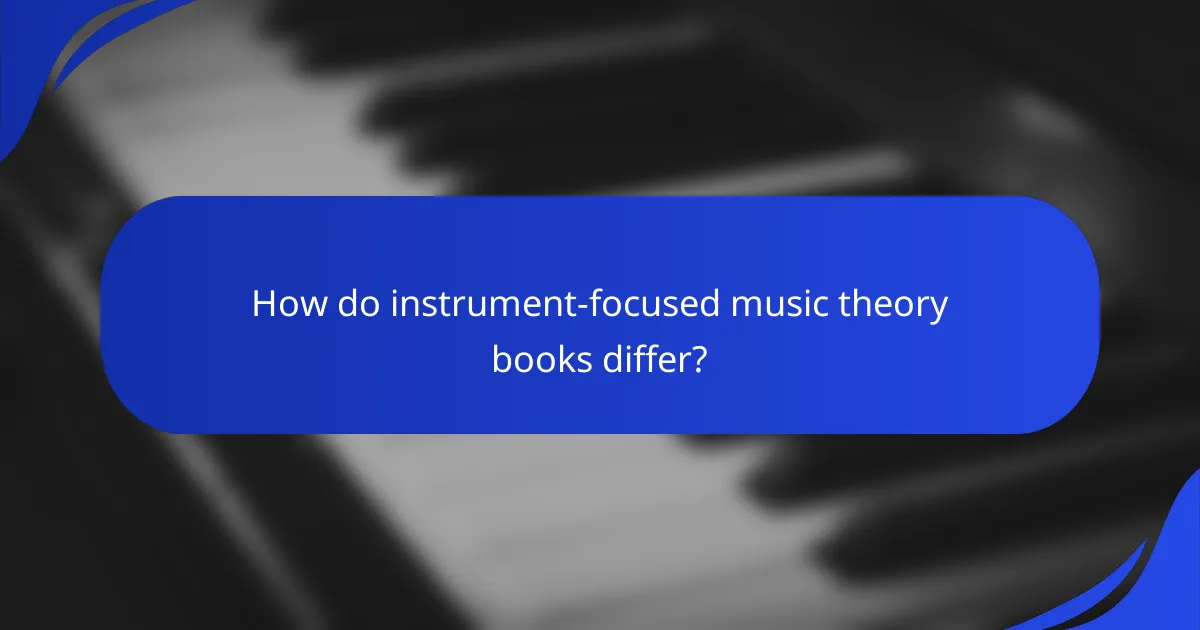
How do instrument-focused music theory books differ?
Instrument-focused music theory books cater to the unique aspects of specific instruments, emphasizing techniques, scales, and harmonies relevant to each. These books often provide tailored exercises and examples that align with the instrument’s capabilities and common playing styles.
“Harmony and Voice Leading” for piano
“Harmony and Voice Leading” is designed specifically for pianists, focusing on the principles of harmony and the movement of voices within music. It teaches how to create rich chord progressions and effective voice leading, which are essential for piano composition and performance.
Key concepts include the use of inversions and the spacing of voices to achieve a balanced sound. Pianists can practice by analyzing classical pieces and applying voice leading techniques to their own compositions.
“The Complete Guitarist” for guitar
“The Complete Guitarist” offers a comprehensive approach to guitar theory, covering everything from basic chords to advanced improvisation techniques. This book emphasizes the importance of understanding the guitar fretboard and how to apply music theory in practical playing scenarios.
Guitarists can benefit from exercises that focus on scale patterns, chord progressions, and rhythm techniques. Regular practice of these elements can enhance both technical skills and musical creativity.
“The Art of Music Theory” for string instruments
“The Art of Music Theory” is tailored for string instrument players, focusing on the nuances of playing techniques and theoretical concepts relevant to violins, violas, and cellos. It covers essential topics such as bowing techniques, finger placement, and the interpretation of musical notation.
Students are encouraged to explore different styles, from classical to contemporary, and apply theoretical knowledge to their practice. Engaging with a variety of pieces can deepen understanding and improve overall musicianship.

What learning approaches do music theory books offer?
Music theory books provide various learning approaches, catering to different preferences and skill levels. These methods include self-paced learning, structured curriculums, and interactive exercises, each designed to enhance understanding and application of music theory concepts.
Self-paced learning
Self-paced learning allows individuals to progress through music theory material at their own speed. This approach is ideal for those who have busy schedules or prefer to take time to fully grasp each concept before moving on. Many self-paced resources include exercises and quizzes to reinforce learning.
When choosing self-paced materials, look for books that offer clear explanations and examples. Consider resources that provide supplementary online content, such as videos or interactive tools, to enhance your understanding. This flexibility can lead to a deeper comprehension of music theory.
Structured curriculum
A structured curriculum provides a systematic approach to learning music theory, often following a specific sequence of topics. This method is beneficial for beginners who need a clear path to follow and for those preparing for formal examinations. Many educational institutions and online courses utilize this approach.
When selecting a structured curriculum, ensure it aligns with your learning goals, whether for personal enrichment or certification. Look for books that include assessments and progress tracking to gauge your understanding as you advance through the material.
Interactive exercises
Interactive exercises engage learners by incorporating practical applications of music theory concepts. These activities can include quizzes, ear training, and composition tasks, making the learning process more dynamic and enjoyable. Many modern music theory books offer companion websites or apps with these features.
To maximize the benefits of interactive exercises, choose resources that provide instant feedback on your performance. This immediate response helps identify areas for improvement and reinforces concepts effectively. Consider integrating these exercises into your regular practice routine for optimal results.
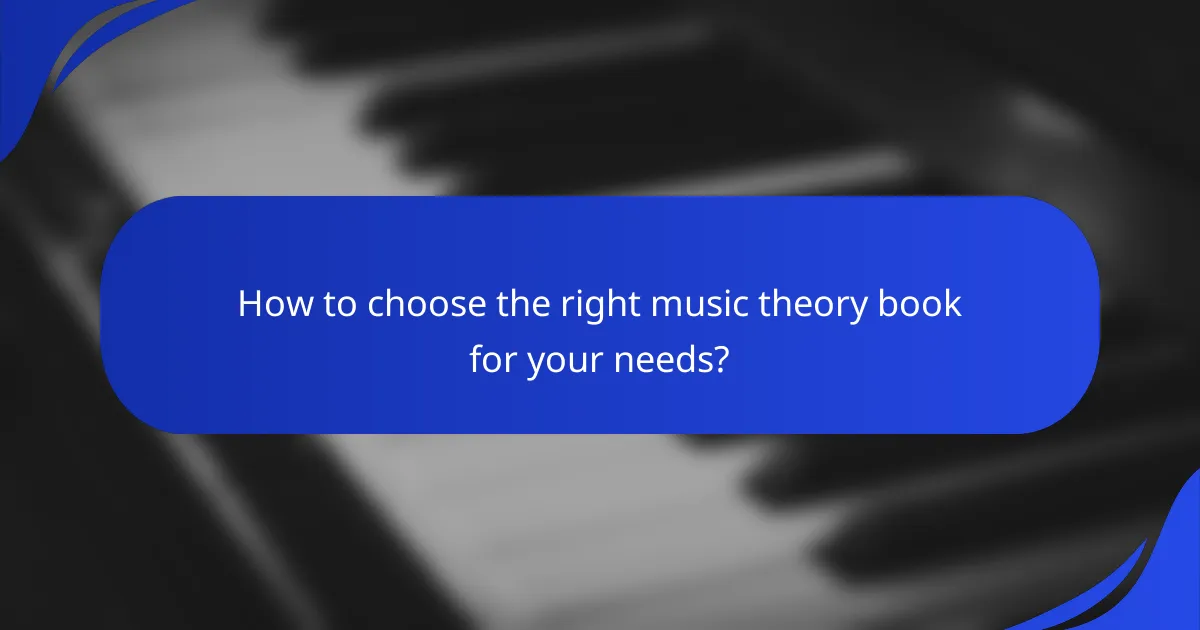
How to choose the right music theory book for your needs?
Choosing the right music theory book depends on your current skill level and your specific musical goals. A well-selected book can enhance your understanding and application of music theory, making your learning process more effective.
Assess your current skill level
Before selecting a music theory book, evaluate your existing knowledge of music theory. Beginners might benefit from introductory texts that cover basic concepts, while intermediate or advanced learners may seek more specialized resources that delve into complex topics.
Consider taking a quick self-assessment quiz or reviewing the table of contents of potential books to gauge their appropriateness. Look for books that clearly state their target audience, as this can help you avoid materials that are too advanced or too simplistic.
Consider your musical goals
Your musical aspirations will significantly influence your choice of a music theory book. If you’re aiming to compose music, look for books that focus on harmony, counterpoint, and form. For those interested in performance, resources that emphasize ear training and rhythmic understanding may be more beneficial.
Additionally, think about the style of music you wish to explore. Books tailored to specific genres, such as jazz or classical, can provide insights and techniques that align with your goals. Make a list of your objectives to help narrow down your options effectively.
